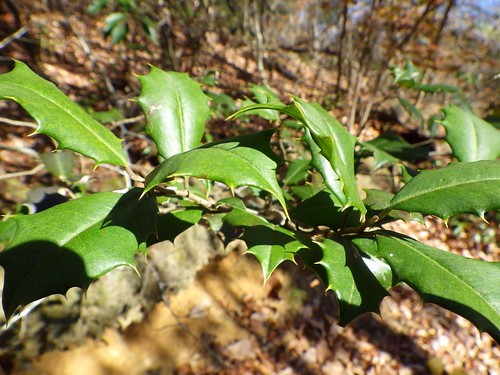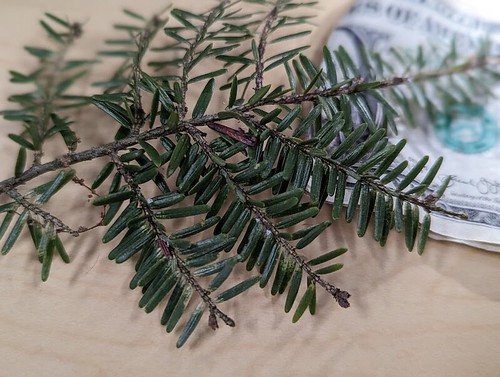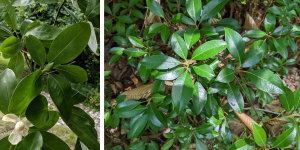
American holly (Ilex opaca) by Edwin Guevara
Winter is here, and for many animals that means either migrating or finding ways to hibernate and become less active in the winter months. For our plants and trees, the options are more limited. When temperatures start to dip and the days begin to shorten, deciduous trees and shrubs lose their leaves. What about plants that have the ability to remain green all year round?

Eastern hemlock (Tsuga canadensis) by Edwin Guevara
American holly (pictured above), eastern hemlock, mountain laurel, sweetbay magnolia, eastern red cedar, as well as a few species of pine, can be found throughout Maryland. These trees and shrubs are excellent for native wildlife and make great additions to any garden. When out in the wild, evergreens are easier to spot during late autumn, winter, and early spring since they remain green throughout the year. This doesn’t mean that they’re growing as actively in the winter as they are in the summer. In fact, they are growing a lot less in the winter, but with their leaves and needles still green they are able to photosynthesize a little, which is more than their deciduous counterparts. When it comes to losing their leaves or needles, they do so throughout the year as opposed to just during autumn. In conifers specifically, they don’t bear fruit in the traditional sense either, instead they produce seeds in cones, such as the well-known pinecones produced by pine trees. These cones can even be good indicators of humidity, since they only open their scales to disperse their seeds when the air is dry and can close the scales back up when humidity increases in the atmosphere.

White pine needle (Pinus strobus) by Edwin Guevara
How do these plants retain green leaves or needles throughout the year? Let’s look at how evergreen plants retain their chlorophyll.
Many evergreens are in the pine family and have needles which are modified leaves. Pine needles can still perform photosynthesis much like normal leaves, yet they can last up to three or four years, offer less wind resistance than normal leaves, and are tougher for insects to eat. Like other evergreens, pines also have a waxy coating that allows them to better retain water. Since the plants must be able to allow water and air to move in and out of the leaf (for photosynthesis), air and water flow is regulated through pores in the needle’s underside. In evergreens, these pores are smaller and more tightly closed than in deciduous species like oaks and maples.

(Left) Sweetbay magnolia (Magnolia virginiana) by Edwin Guevara; (right) mountain laurel (Kalmia latifolia) by Edwin Guevara
Much like their pine counterpart, broadleaf evergreen plants have a waxy coating made of cutin on their leaves that aid them in insulation from cold temperatures and shield them from the elements. It is easier to notice the wax on broader leaves due to how shiny they appear and how rigid they feel when touched. Sweetbay magnolia, pictured above, is considered semi-evergreen. In harsher colder climates further north, they may lose all of their leaves in the winter, but during milder winters of the mid-Atlantic, they mostly retain their leaves year round. Other broadleaf evergreen plants like mountain laurel and American holly retain their leaves throughout the year. Many evergreen leaves also turn darker in color during the winter to enable the plant to mitigate water loss problems. On warmer winter days, those dark needles absorb heat and raise the temperature within the tree canopy above the surrounding air temperature. This increases the tree’s metabolic rate as the pressure of water inside the tree rises and is relieved by water loss through the needle pores. You can see this phenomenon on warm winter days by looking for a mist around the conifers of Swallow Falls in Herrington Manor State Park. Cooler, cloudy days in winter are actually better for the tree.

Hemlock woolly adelgid
While on the topic of evergreens, here are links to some interesting facts about eastern hemlock and its common pest, the hemlock wooly adelgid, or HWA.
- Integrated Approach to Hemlock Woolly Adelgid Mitigation from PennState Extension
- Hemlock Woolly Adelgid from Maryland Department of Agriculture
If you enjoy looking at evergreens and other sights of winter, we recommend you use our scavenger hunt or try going on a conifer quest!
Welcome HabiChatters to the 2023 winter issue!
In this issue, Education Ecologist Paula Becker starts us off with a fantastic overview of what is happening in the natural world at this time of year, and then I’ll tell you some of what we’re up to in the Natural Heritage Program. Education Assistant Edwin Guevara writes about some of our favorite winter wildlife, owls and evergreens. And, if our newsletter didn’t fully feed your craving for reading, I’ve included a reading list to inspire and delight. We hope you enjoy and wish you a very Happy New Year from the education team at Wild Acres!
Click here to have HabiChat—the quarterly backyard wildlife habitat newsletter from the Wild Acres program—delivered right to your inbox!
In this Issue
- In Praise of Dormancy
- Natural Heritage Program’s Winter Work: Revisiting Maryland’s Tiger Salamanders
- Native Animal Profile: Stealthy (and Cute!) Owls
- A Cozy Winter Reading List for 2023

